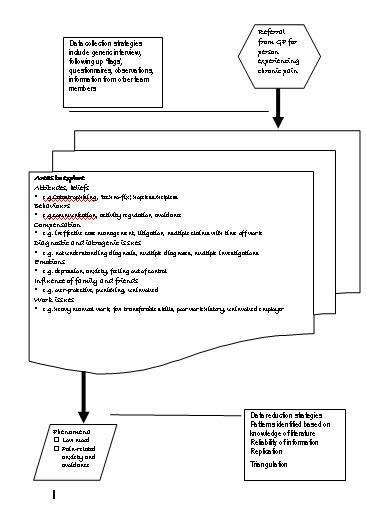 | ||
A clinical formulation, also known as case formulation, is a theoretically-based explanation or conceptualisation of the information obtained from a clinical assessment. It offers a hypothesis about the cause and nature of the presenting problems and is considered an adjunct or alternative approach to the more categorical approach of psychiatric diagnosis. In clinical practice, formulations are used to communicate a hypothesis and provide framework for developing the most suitable treatment approach. It is most commonly used by clinical psychologists and psychiatrists and is deemed to be a core component of these professions. Mental health nurses and social workers may also use formulations.
Contents
Types of formulation
Different psychological schools or models utilize clinical formulations, including cognitive behavioral therapy (CBT) and related therapies: systemic therapy, psychodynamic therapy, and applied behavior analysis. The structure and content of a clinical formulation is determined by the psychological model. Most systems of formulation contain the following broad categories of information: symptoms and problems; precipitating stressors or events; predisposing life events or stressors; and an explanatory mechanism that links the preceding categories together and offers a description of the precipitants and maintaining influences of the person's problems.
Behavioral case formulations used in applied behavior analysis and behavior therapy are built on a rank list of problem behaviors, from which a functional analysis is conducted, sometimes based on relational frame theory. Such functional analysis is also used in third-generation behavior therapy or clinical behavior analysis such as acceptance and commitment therapy and functional analytic psychotherapy. Functional analysis looks at setting events (ecological variables, history effects, and motivating operations), antecedents, behavior chains, the problem behavior, and the consequences, short- and long-term, for the behavior.
A model of formulation that is more specific to CBT is described by Jacqueline Persons. This has seven components: problem list, core beliefs, precipitants and activating situations, origins, working hypothesis, treatment plan, and predicted obstacles to treatment.
A psychodynamic formulation would consist of a summarizing statement, a description of nondynamic factors, description of core psychodynamics using a specific model (such as ego psychology, object relations or self psychology), and a prognostic assessment which identifies the potential areas of resistance in therapy.
One school of psychotherapy which relies heavily on the formulation is cognitive analytic therapy (CAT). CAT is a fixed-term therapy, typically of around 16 sessions. At around session four, a formal written reformulation letter is offered to the patient which forms the basis for the rest of the treatment. This is usually followed by a diagrammatic reformulation to amplify and reinforce the letter.
Many psychologists use an integrative psychotherapy approach to formulation. This is to take advantage of the benefits of resources from each model the psychologist is trained in, according to the patient's needs.
Critical evaluation of formulations
The quality of specific clinical formulations, and the quality of the general theoretical models used in those formulations, can be evaluated with criteria such as:
Formulations can vary in temporal scope from case-based to episode-based or moment-based, and formulations may evolve during the course of treatment. Therefore, ongoing monitoring, testing, and assessment during treatment are necessary: monitoring can take the form of session-by-session progress reviews using quantitative measures, and formulations can be modified if an intervention is not as effective as hoped.
